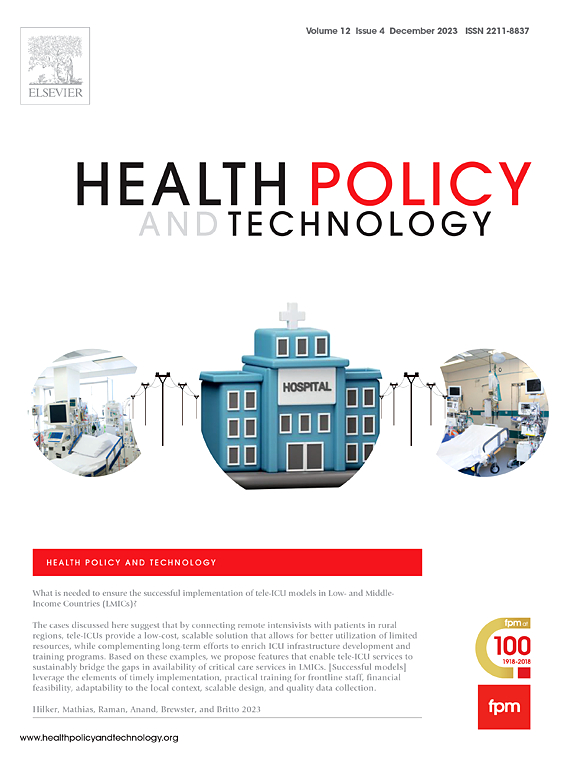苏格兰纳洛酮带回家方案的影响评价
IF 3.7
3区 医学
Q1 HEALTH POLICY & SERVICES
引用次数: 0
摘要
目的描述自全国“带回家”纳洛酮计划(NNP)实施以来,在实施前基线(2006 - 2010)和实施后10年(2011 - 2020)期间,苏格兰各地记录的阿片类药物相关死亡(ORDs)的变化。描述和说明在同一实施前和实施后的4周内出狱和出院后口服药物摄入量的变化,并评估在此期间有阿片类药物过量风险的人获得纳洛酮的范围。方法描述性统计作为中学前后贡献分析方法的一部分。利用更好的评价彩虹框架进行影响评价,数据来自苏格兰公共卫生部的官方统计数据和监测报告。结果nnp实施后,全国ORDs总数有所增加。2006 - 2010年,9.8%的残疾人士(1970年有193人)是在死亡后4周内从监狱释放的,而2011 - 2020年只有4.4%的残疾人士(6439人中有281人)是在监狱释放后获得残疾人士的,减少了55%。出院后,没有观察到类似的ORDs减少。在实施后期间,有阿片类药物过量风险的个体累计获得纳洛酮的覆盖率为58%。苏格兰NNP的实施恰逢全国范围内ord总数的增加,用于管理阿片类药物过量的纳洛酮的可得性增加,以及最近释放的囚犯中阿片类药物相关死亡比例的减少。不幸的是,出院后发生ord的比例保持不变,这表明这一人群可能受益于进一步的研究和其他分布方法。本文章由计算机程序翻译,如有差异,请以英文原文为准。
An impact evaluation of the Scottish take-home naloxone programme
Objectives
To describe the change in opioid-related deaths (ORDs) recorded across Scotland since National ‘Take Home’ Naloxone Programme (NNP) implementation between baseline pre-implementation (2006 – 2010) and 10-year post implementation (2011 – 2020) periods. To describe and contextualise the change in ORDs within 4 weeks of prison release and hospital discharge across the same pre- and post-implementation periods and evaluate the reach of naloxone to people at risk of opioid overdose during this period.
Methods
Descriptive statistics as part of a pre-post secondary contribution analysis approach. The Better Evaluation Rainbow Framework for impact evaluation was utilised and data was obtained from official statistics and monitoring reports via Public Health Scotland.
Results
An increase in total ORDs nationwide was observed post-NNP implementation. In 2006–10, 9·8 % of ORDs (193 of 1970) were in people released from prison within 4 weeks of death, whereas only 4·4 % of ORDs (281 of 6439) in 2011–20 followed prison release, representing a 55 % reduction. A similar reduction in ORDs following hospital discharge was not observed. Cumulative reach of take-home naloxone to individuals at risk of opioid overdose across the post-implementation period was 58 %.
Conclusions
Implementation of the Scottish NNP has coincided with an increase in total ORDs nationwide, increased availability of take-home naloxone for management of opioid overdose and a reduction in the proportion of opioid-related fatalities among recently released prisoners. Unfortunately, the proportion ORDs after hospital discharge remain unchanged suggesting that this population may benefit from further research and additional distribution approaches.
求助全文
通过发布文献求助,成功后即可免费获取论文全文。
去求助
来源期刊

Health Policy and Technology
Medicine-Health Policy
CiteScore
9.20
自引率
3.30%
发文量
78
审稿时长
88 days
期刊介绍:
Health Policy and Technology (HPT), is the official journal of the Fellowship of Postgraduate Medicine (FPM), a cross-disciplinary journal, which focuses on past, present and future health policy and the role of technology in clinical and non-clinical national and international health environments.
HPT provides a further excellent way for the FPM to continue to make important national and international contributions to development of policy and practice within medicine and related disciplines. The aim of HPT is to publish relevant, timely and accessible articles and commentaries to support policy-makers, health professionals, health technology providers, patient groups and academia interested in health policy and technology.
Topics covered by HPT will include:
- Health technology, including drug discovery, diagnostics, medicines, devices, therapeutic delivery and eHealth systems
- Cross-national comparisons on health policy using evidence-based approaches
- National studies on health policy to determine the outcomes of technology-driven initiatives
- Cross-border eHealth including health tourism
- The digital divide in mobility, access and affordability of healthcare
- Health technology assessment (HTA) methods and tools for evaluating the effectiveness of clinical and non-clinical health technologies
- Health and eHealth indicators and benchmarks (measure/metrics) for understanding the adoption and diffusion of health technologies
- Health and eHealth models and frameworks to support policy-makers and other stakeholders in decision-making
- Stakeholder engagement with health technologies (clinical and patient/citizen buy-in)
- Regulation and health economics
 求助内容:
求助内容: 应助结果提醒方式:
应助结果提醒方式:


